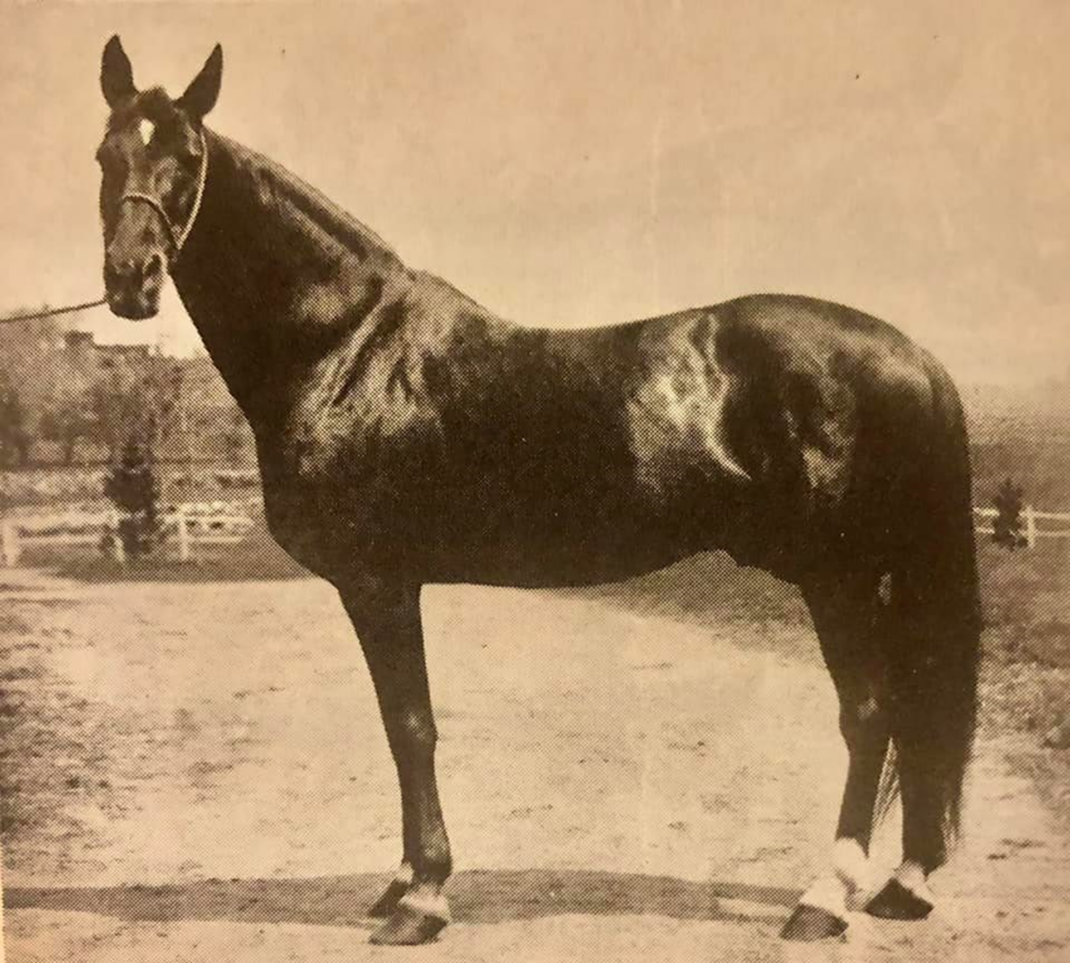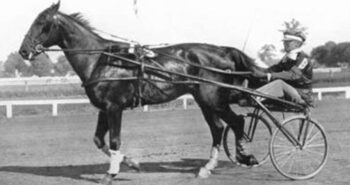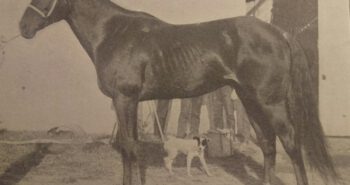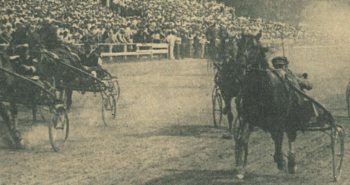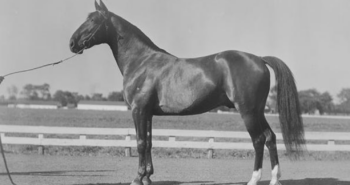The colt had talent, but had inherited his sire’s poor feet and was rushed too early to the races and as a result barely raced because of his lameness. Showing exceptional speed, his new owner decided to gamble on the six-year-old colt at stud. Virtually everybody thought it was a ridiculous folly of judgment. However, John Shults had the last laugh as Axworthy turned out to be one of the foundation sires of the standardbreds.
The story of Axworthy starts with the syndication of his sire Axtell in 1889, which was headed by John Conley of Chicago. One of his friends was Alfred B. Darling of New York City, owner of the famous Fifth Avenue Hotel as well as the Darlington stud farm in New Jersey. Several years prior, Darling had acquired Old Daisy, a grey mare of unknown origins known for tremendous speed as a road horse. He resorted to breeding the mare to the best stallions. Old Daisy was first bred to the very fast Strideaway. The resulting mare, Young Daisy, was deemed so valuable she went straight into the broodmare band at the farm and bred at 3.
In 1873 Darling bought the three-year-old Kentucky Prince, a paternal grandson of Mambrino Chief and whose pedigree had a mix of Morgan and thoroughbred blood without a trace of Hambletonian. The horse was sold five years later and ended up at the famous Stony Ford farm, where he would prove his worth as a sire of speed. Though the stallion was gone, Darling had kept several of his daughters. One was the 1876 filly Marguerite, whose dam was Young Daisy. Come 1890, Marguerite was one of two mares sent from the Darlington farm to Indiana to be bred to Axtell. So pleasing were the foals that Marguerite actually had seven foals by Axtell. The first foal died at two, while of the remaining six, five took records.
An unsound talent
The second of Marguerite’s foals was the 1892 foal Axworthy. The colt was left at Terre Haute and developed by famous horseman Budd Doble. Because of the syndicate’s strong desire to showcase his prowess as a sire, Axtell’s get was generally rushed to the tracks. In 1894, five of his two-year-olds made the 2:30 list, a record at the time. However, many were not ready yet. One of the five foals was Axworthy, who had massive talent but needed time to grow and develop into his body – time he wasn’t given. On Jul 29, 1894, several US newspapers reported that “The young Axtells are going fast at Terra Haute, and trainer Young has recently given several exhibitions with them. He drove Axtelloid a quarter in 36, Axworthy in 33 3/4 and Praytell in 34.”
Having shown a lot of promise, Axworthy was prepared for a meeting with Oakland Baron in August 1894. The latter regarded as the fastest 2-year-old in Kentucky at the time. In the end, Oakland Baron narrowly won both heats, though Axworthy was game and put in solid finishes both times, the first in 2:23 1/2 (1.29,2) and the second in 2:16 1/2 (1.24,8). The latter was a new world record for the age group. Wanting to give the two-year-old a record, on Sep 15 he trialed to beat 2:30 at Terra Haute. Axworthy managed that relatively easy when he came home in 2:28 3/4 (1.32,4). After that he was laid up.
As Doble returned to California at the end of the year, Axworthy was trusted to John Young, the man who had driven Axworthy in this successful time trial. Young had great hopes for Axworthy’s three-year-old season, and the Indianapolis News wrote on Jun 11, 1895, that “these Axtells are speeding at a tremendous rate. Probably the sorrel colt Axworthy is the most promising. Last year he trotted some good races, but did not make a race record. Late in the season he obtained a record of 2:28 1/2 (1.32,3). He had, however, trainer Young told me, showed a trial in 2:16 (1.24,5) as a two-year-old, and beat 2:20 (1.27,0) in his race. Axworthy was a pretty good two-year-old.” (Note: The article was slightly wrong: Axworthy only started in one race and obtained a record of 2:28 3/4 in the trial.)
The three-year-old was well-known and regularly mentioned in the newspapers, though. The Chicago Tribune wrote on Jul 15, that “Axworthy, the 3-year-old Axtell colt owned by Mr Darling of the Fifth Avenue Hotel, New York, went a half mile on the track [at Terra Haute] yesterday in 1:05, ” and when The Inter Ocean ran an article “Axtell’s good colts” on Sep 15, the subtitle was “Trainer Young thinks Axworthy the best of them.”
However, despite all the positive press, a troublesome front knee made the colt miss out on all key races that season. Late in the season a race was organized back home at Terra Haute to get the colt a record. Axworthy lost the first heat despite easy opposition, but came back to win the next two, the second in 2:15 1/2 (1.24,2). It would be his last race as soundness issues prevented Axworthy from being trained regularly.
The following year, on Sep 6,1896, Axworthy’s breeder and owner Darling passed away, aged 75, never recovering after being thrown from his carriage while riding on his estate several months prior. Three months later, on December 2, the then 4-year-old colt was led into the ring at the dispersal auction arranged by his estate. From a financial perspective the timing was terrible as the US was in the depths of a depression and values were rock bottom. Nobody dared gamble on the unsound colt and Axworthy looked set to exit the ring without a single bid.
The accidental purchase
Coincidentally, just at that time John H. Shults entered the auction premises. He asked what they were unable to sell and upon learning it was Axworthy, who was supposedly the highlight the Darling dispersal, declared this was shameful. Shults had been one of Darling’s closest friends and decided to get things going with a bid of 500 dollars. However, with no other interest, he soon found himself the owner of the Axtell son. Shults, who owned both the Parkville and Shultshurst farms, was expected to sell Axworthy when times improved.
However, the longer Shults owned the colt, the more he liked him. At 6, Axworthy had fully developed and was sufficiently sound to be driven lightly. Shults showed off Axworthy to his friends, who were impressed as the colt supposedly “exhibited a magnificent way of going, brushing short journeys at an extreme rate.” Soon enough, Shults decided to instead sell his primary stallion, Stranger, and elevate Axworthy to that position. It was a decision many thought ridiculous all the time. After all, Stranger was a premier stallion while Axworthy was a cheap stallion bought simply because nobody else was interested.
The spectacular sire
While other breeders, and the trotting world, considered Shults to be exercising terrible judgment, it soon became evident it was the other way around. In very little time, Axworthy showed himself to be an excellent sire of early speed. The 1900 crop contained the good Tom Axworthy 2:07 (1.18,9), and the following crop contained the speedy filly Alta Axworthy, second in the 1904 Kentucky Futurity.
1902 saw the birth of Axworthy’s legendary daughter Hamburg Belle, John Madden’s speedy 2:01.1 (1.15,3) mare as well as Guy Axworthy, whose 2:08 3/4 (1.20,0) record in 1906 was the fastest mark by a four-year-old that year. Guy Axworthy sired three Hambletonian winners, in addition to being the damsire of another three, and would be the primary line extender together with 1910-colt Dillon Axworthy. Hamburg Belle broke the three-heat world record at Hartford, CT 1908, trotting in in 2:05, 2:06 and 2:04 3/4 (1.17,7, 1.18,3 and 1.17,5). The following year she defeated Uhlan in two straight heats at the North Randall track at Cleveland. Her wins in 2:01 1/4 and 2:01 3/4 (1.15,4 and 1.15,6) was a two-heat world record which stood for 15 years. Hamburg Belle showed exceptional abilities, yet is largely unknown as she died just a few months later of pneumonia.
1907 saw his only Kentucky Futurity winner in General Watts 3,2:06 3/4 (1.18,8) as well as Hailworthy 2:05 1/4 (1.17,8). Other noteworthy performers include Axtien 2:06 1/4 (1.18,5), Ortolan Axworthy 2:07 1/2 (1.19,2), Queen Worthy 2:07 1/2 (1.19,2), Adlon 2:07 3/4 (1.19,4), Bright Axworthy 2:08 (1.19,6), Rusticott 2:08 1/4 (1.19,7), Olcott Axworthy 2:08 1/2 (1.19,9) and Worthy Volo 2:08 3/4 (1,20,0).
As an interesting observation, Guy Axworthy’s damsire was Guy Wilkes, the full brother to Axworthy’s paternal grandsire William L. Guy Wilkes was also the damdamsire of Dillon Axworthy, while Hamburg Belle’s damsire Simmons was another son of George Wilkes. It’s safe to say doubling, or even tripling, up on George Wilkes and his sons paid off handsomely. Not only that, Guy Axworthy and Dillon Axworthy were far from clones of their sires. They all had a majestic presence about them. However, while their sire was chestnut and measured 15.3 hands (160 cms), his top two sons were both bay and smaller, around 15 hands (152-153 cms). His sons, and Hamburg Belle also fits into this category, were also very refined in type – more so than their sire. If anything, the description of Guy and Dillon Axworthy resembles somebody else in their pedigree – surprise, surprise – their paternal grandsire Axtell as well as the horse they are doubled up on, George Wilkes.
Sold again
In the autumn of 1906, when Shults had decided to retire from breeding due to his age, Axworthy was again entered into the auction ring. This time, at Madison Square Garden, the colt was extremely sought after and the price for the 14-year-old stallion reached $21,000. The buyer was William Simpson, who already had the excellent McKinney 2.11 1/4 (1.21,6) standing stud at his farm in Cuba, New York. For this reason, after two seasons at stud there he decided to send Axworthy to Kentucky ahead of the 1909 season, and the foundation stallion spent the rest of his life at RL Nash’s Mansfield Farm in the Bluegrass state.
Axworthy died on November 5, 1917, aged 25. He was by then considered one of the key stallions in the trotting world – a far cry from the situation when he was bought at auction by Shults in a failed effort to get the bidding going.
Axworthy
Chestnut colt born in Ramsay, NJ in 1892. Died in Lexington, KY on Nov 5, 1917.
Axtell – Marguerite (Kentucky Prince)
2 starts: 1-1-0 – 3, 2:15 1/2 (1.24,2)
Breeder: Alfred B. Darling
Owners: Alfred B Darling – John H Shults – William Simpson
Trainers: Budd Doble and John Young
Drivers: Budd Doble and John Young
Groom: –

